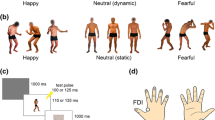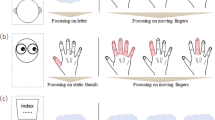Abstract
The current study tests whether manipulating simple motor movements can regulate one’s physiological reactivity to negative images. Healthy college age participants were randomly assigned to no tapping, steady tapping, or slow tapping conditions and viewed two sets of 15 negative images from the international affective picture system. Participants viewed the first image set without manipulation. During the second image set, they were instructed to tap at a steady pace, a slow pace or not at all. Steady tapping suppressed the vagal component of the cardiovascular defense response, and produced a significant increase in respiration rate and skin conductance level (SCL). Slow tapping suppressed the sympathetic and enhanced the vagal components of the cardiovascular defensive response, and produced a decrease in heart rate, SCL and skin conductance responses to negative images. Results suggest that manipulating simple motor movements is an effective way to both up-regulate and more importantly, down-regulate one’s physiological response to negative affective images. Manipulation of slow and simple motor movements may be an effective means to attenuate autonomic arousal.



Similar content being viewed by others
Notes
IAPS images used: violence (6260, 6300, 6230, 6370, 6570.1, 6550, 6510, 9410, 6313, 6250.1) Mutilation (3068, 3053, 3060, 3010, 3064, 3170, 3130, 3063, 3069, 3080). Neutral (5500, 5510, 5520, 5530, 5531).
References
Benjamini, Y., & Hochberg, Y. (1995). Controlling the false discovery rate: A practical and powerful approach to multiple testing. Journal of the Royal Statistical Society. Series B (Methodological), 57, 289–300.
Bramble, D. M., & Carrier, D. R. (1983). Running and breathing in mammals. Science, 219, 251–256. doi:10.1126/science.6849136.
Craig, A. D. (2002). How do you feel? Interoception: The sense of the physiological condition of the body. Neuroscience, 3, 655–665. doi:10.1038/nrn894.
Craig, A. D. (2003). A new view of pain as a homeostatic emotion. Trends in Neurosciences, 26, 303–307. doi:10.1016/S0166-2236(03)00123-1.
Craig, A. D. (2008). Interoception and emotion: A neuroanatomical perspective. In M. Lewis, J. M. Haviland-Jones & L. F. Barret (Eds.), Handbook of emotions (3rd edn., pp. 272–289). New York, NY: The Guilford Press.
Cuthbert, B. N., Bradleym, M. M., & Lang, P. J. (1996). Probing picture perception: Activation and emotion. Psychophysiology, 33(2), 103–111. doi:10.1111/j.1469-8986.1996.tb02114.x.
Davidson, R. J., Horowitz, M. E., Schwartz, G. E., & Goodman, D. M. (1981). Lateral differences in the latency between finger tapping and the heart beat. The Society for Psychophysiological Research, 18, 36–41. doi:10.1111/j.1469-8986.1981.tb01539.x.
Dunn, B. D., Galton, H. C., Morgan, R., Evans, D., Oliver, C., Meyer, M., Cusack, R., Lawrence, A. D., & Dalgleish, T. (2010). Listening to your heart: How interoception shapes emotion experience and intuitive decision making. Psychological Science, 21, 1835–1844. doi:10.1177/0956797610389191.
Fernández, M. C., & Vila, J. (1989). Sympathetic-parasympathetic mediation of the cardiac defense response in humans. Biological Psychology, 28(2), 123–133. doi:10.1016/0301-0511(89)90094-X.
Fitzsimons, G. M., & Bargh, J. A. (2004). Automatic self-regulation. In R. F. Baumeister & K. D. Vohs (Eds.), Handbook of self-regulation (pp. 151–170). New York, NY: The Guilford Press.
Goldin, P. R., & Gross, J. J. (2010). Effects of mindfulness-based stress reduction (MBSR) on emotion regulation in social anxiety disorder. Emotion (Washington, D. C.), 10, 83–91. doi:10.1037/a0018441.
Gross, J. J. (1998). Antecedent-and response-focused emotion regulation: Divergent consequences for experience, expression, and physiology. Journal of personality and social psychology, 74(1), 224. doi:10.1037/0022-3514.74.1.224.
Gross, J. J. (1999). Emotion regulation: Past, present, future. Cognition & Emotion, 13, 551–573. doi:10.1080/026999399379186.
Gross, J. J., & Levenson, R. W. (1997). Hiding feelings: The acute effects of inhibiting negative and positive emotion. Journal of abnormal psychology, 106(1), 95–103. doi:10.1037/0021-843X.106.1.95.
Gyurak, A., Gross, J. J., & Etkin, A. (2011). Explicit and implicit emotion regulation: A duel-process framework. Cognition & Emotion, 25, 400–412. doi:10.1080/02699931.2010.544160.
Hopp, H., Troy, A. S., & Mauss, I. B. (2011). The unconscious pursuit of emotion regulation: Implications for psychological health. Cognition and Emotion, 25, 532–545. doi:10.1080/02699931.2010.532606.
Kirby, R. L., Carr, S. E., & MacLeod, D. A. (1990). Cardiac-locomotor coupling while finger tapping. Perceptual and Motor Skills, 71, 1099–1104. doi:10.2466/PMS.71.8.1099-1104.
Kohl, J., Koller, E. A., & Jager, M. (1981). Relation between pedalling and breathing rhythm. European Journal of Applied Physiological Occupational Physiology, 47, 223–237. doi:10.1007/BF00422468.
Koole, S. L., & Rothermund, K. (2011). “I feel better and don’t know why”: The psychology of implicit emotion regulation. Cognition & Emotion, 25, 389–399. doi:10.1080/02699931.2010.550505.
Lang, P. J., Bradley, M. M., & Cuthbert, B. N. (1997). Motivated attention: Affect, activation, and action. Attention and orienting: Sensory and motivational processes (pp. 97–135). Mahwah, NJ: Lawrence Erlbaum Assosciates, Inc.
Lang, P. J., Bradley, M. M., & Cuthbert, B. N. (2008). International affective picture system (IAPS): affective ratings of pictures and instruction manual. Technical Report A-7. Gainesville, FL: University of Florida.
Mahler, D. A., Hunter, B., Lentine, T., & Ward, J. (1991). Locomotor-respiratory coupling develops in novice female rowers with training. Medical Science Sports Exercise, 23, 1362–1366.
Mauss, I. B., Cook, L. C., & Gross, J. J. (2007). Automatic emotion regulation during anger provocation. Journal of Experimental Social Psychology, 43, 698–711. doi:10.1016/j.jesp.2006.07.003.
Mauss, I. B., Evers, C., Wilhelm, F. H., & Gross, J. J. (2006). How to bite your tongue without blowing your top: Implicit evaluation of emption regulation predicts affective responding to anger provocation. Personality and Social Psychology Bulletin, 32, 589–602. doi:10.1177/0146167205283841.
McGlone, F., Vallbo, A. K., Olausson, H., Loken, L., & Wessberg, J. (2007). Discrimative touch and emotional touch. Canadian Journal of Experimental Psychology, 61, 173–183. doi:10.1037/cjep2007019.
Mravec, O. K. (2010). Multilevel interactions between the sympathetic and parasympathetic nervous systems: a minireview. Endocrine Regulations, 44, 69–75.
Mund, M., & Mitte, K. (2012). The costs of repression: A meta-analysis on the relation between repressive coping and somatic diseases. Health psychology, 31(5), 640. doi:10.1037/a0026257.
Nolan, R. P., Kamath, M. V., Floras, J. S., Stanley, J., Pang, C., Picton, P., & Young, Q. R. (2005). Heart rate variability biofeedback as a behavioral neurocardiac intervention to enhance vagal heart rate control. American Heart Journal, 149(6), 1137–1131. doi:10.1016/j.ahj.2005.03.015.
Obrist, P. A. (1975). Presidential address, 1975: The cardiovascular-behavioral interaction-as it appears today. Psychophysiology, 13, 95–107. doi:10.1111/j.1469-8986.1976.tb00081.x.
Polak, A. R., Witteveen, A. B., Denys, D., & Olff, M. (2015). Breathing Biofeedback as an Adjunct to Exposure in Cognitive Behavioral Therapy Hastens the Reduction of PTSD Symptoms: A Pilot Study. Applied psychophysiology and biofeedback, 40(1), 25–31. doi:10.1007/s10484-015-9268-y.
Prinsloo, G. E., Derman, W. E., Lambert, M. I., & Rauch, H. L. (2013). The effect of a single session of short duration biofeedback-induced deep breathing on measures of heart rate variability during laboratory-induced cognitive stress: A pilot study. Applied psychophysiology and biofeedback, 38(2), 81–90. doi:10.1007/s10484-013-9210-0.
Raio, C. M., Orederu, T. A., Palazzolo, L., Shurick, A. A., & Phelps, E. A. (2013). Cognitive emotion regulation fails the stress test. Proceedings of the National Academy of Sciences, 110(37), 15139–15144. doi:10.1073/pnas.1305706110.
Ramírez, I., Guerra, P., Perakakis, P., Anllo-Vento, L., & Vila, J. (2010). The dynamics of cardiac defense: From attention to action. Psychophysiology, 47(5), 879–887. doi:10.1111/j.1469-8986.2010.01008.x.
Sheppes, G., Scheibe, S., Suri, G., & Gross, J. J. (2011). Emotion regulation choice. Psychological Science, 22, 1391–1396. doi:10.1177/0956797611418350.
Vallbo, A. B., & Wessberg, J. (1993). Organization of motor output in slow finger movements in man. Journal of Physiology, 469, 673–691. doi:10.1113/jphysiol.1993.sp019837.
Vila, J., Pérez, M. N., Fernández, M. D. C., Pegalajar, J., & Sánchez, M. (1997). Attentional modulation of the cardiac defense response in humans. Psychophysiology, 34(4), 482–487. doi:10.1111/j.1469-8986.1997.tb02393.x.
Wessberg, J., & Vallbo, A. B. (1995). Coding of pulsatile motor output by human muscle afferents during slow finger movements. Journal of Physiology, 485, 271–282. doi:10.1113/jphysiol.1995.sp020729.
Wilke, J. T., Lansing, R. W., & Rogers, C. A. (1975). Entrainment of respiration to repetitive finger tapping. Physiological Psychology, 3, 345–349. doi:10.3758/BF03326838.
Author information
Authors and Affiliations
Corresponding author
Rights and permissions
About this article
Cite this article
Stearns, S.S., Fleming, R. & Fero, L.J. Attenuating Physiological Arousal Through the Manipulation of Simple Hand Movements. Appl Psychophysiol Biofeedback 42, 39–50 (2017). https://doi.org/10.1007/s10484-017-9350-8
Published:
Issue Date:
DOI: https://doi.org/10.1007/s10484-017-9350-8




